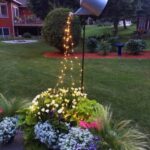When it comes to transforming your outdoor space into a stunning garden oasis, one of the most crucial steps is designing a well-thought-out layout. A carefully planned garden layout not only enhances the overall aesthetic appeal but also ensures functionality and ease of maintenance. Whether you are starting from scratch or revamping an existing garden, understanding the importance of design principles and strategic plant selection is key to creating your dream garden.
A well-designed garden layout holds immense significance for both homeowners and gardening enthusiasts. By carefully considering factors like sunlight, soil quality, and water availability, you can make informed decisions about which plants will thrive in your garden space. Additionally, paying attention to design principles such as unity, balance, and focal points allows you to create a visually appealing environment that soothes the senses.
An aesthetically pleasing garden not only serves as an extension of your living space but also provides a sanctuary where you can relax and rejuvenate. It offers endless possibilities for entertaining guests or simply enjoying some quiet time amidst nature’s beauty. Moreover, with careful planning and organization, a thoughtfully designed garden layout can minimize maintenance efforts and ensure long-term success.
So get ready to embark on this exciting journey of designing your very own garden layout. In the following sections, we will explore the basics of assessing your garden space, delve into design principles that will help you visualize your dream garden, discuss practical considerations to incorporate functionality into your design, and provide tips on maintenance and care to sustain the beauty of your new creation. Let’s bring life to your outdoor space through thoughtful design.
Understanding the Basics
Assessing your garden space is a crucial step in designing a successful garden layout. By understanding the basics of your garden, such as its size, shape, and conditions, you can make informed decisions about the plants and features to include in your design.
To begin assessing your garden space, start by measuring the dimensions of your garden area. This will help you determine how much space you have to work with and will be useful when creating a scaled-down map of your garden later on in the planning process.
Next, evaluate the conditions of your garden such as sunlight, water availability, and soil quality. Take note of which areas receive the most sunlight throughout the day, as this will determine where you can plant sun-loving plants. Similarly, consider any areas that are shaded for most of the day or have poor soil quality, as these areas may require special attention or different plant choices.
In addition to considering natural factors like sunlight and soil quality, also take into account any existing features or structures in your garden that may influence your design. This could include trees or large shrubs that you want to keep as focal points or obstacles like fences or utility boxes that need to be incorporated into your design.
By thoroughly assessing your garden space at the outset of the design process, you can ensure that your final design is well-suited to the unique characteristics of your garden. Taking these steps will set a strong foundation for creating a beautiful and functional outdoor space that you can enjoy for years to come.
| Aspect | Considerations |
|---|---|
| Size | Determine the dimensions of your garden area. |
| Shape | Note any irregular shapes or unique features in your garden. |
| Sunlight | Identify areas that receive the most and least sunlight. |
| Water Availability | Evaluate the proximity of water sources to your garden space. |
| Soil Quality | Determine the overall quality of your garden’s soil. |
Exploring Design Principles
Designing a garden layout is not only about creating a functional space, but it is also an opportunity to showcase your creativity and personal style. In this section, we will explore the important design principles that can help you create a vision for your garden and bring it to life.
Unity
One of the fundamental design principles in creating a garden layout is unity. Unity refers to the overall cohesion and harmony of the elements in your garden. It involves choosing a coherent theme or style and applying it consistently throughout your space. By selecting plants, colors, materials, and accessories that complement each other, you can achieve a unified look for your garden.
Balance
Another key principle is balance. Balance in garden design involves achieving visual equilibrium by distributing elements evenly throughout the space. There are two types of balance: symmetrical and asymmetrical. Symmetrical balance involves arranging elements equally on both sides of a central axis, while asymmetrical balance involves creating equilibrium through various shapes, sizes, colors, and textures.
Focal Points
Creating focal points is another essential aspect of designing a garden layout. Focal points are areas or features in the garden that draw attention and serve as visual anchors. They can include eye-catching elements like statues, water features, or unique plants. Focal points help create depth and interest in your garden by giving viewers something to focus on when they first enter or navigate through the space.
When exploring design principles for your garden layout, it’s essential to consider what speaks to you personally in terms of style and aesthetics. Whether you prefer formal gardens with structured lines or more informal cottage-style gardens bursting with color and texture, incorporating design principles can help you develop a cohesive vision for your own unique outdoor oasis.
Planning Your Garden Layout
Importance of Planning Your Garden Layout
When it comes to designing a garden, planning is an essential step that should not be overlooked. By mapping out the space beforehand, you can ensure that your garden layout is well-thought-out and meets both your aesthetic and functional needs. This section will guide you through the process of planning your garden layout, emphasizing the importance of scale and proportion in design.
Considering Scale and Proportion
One crucial aspect of planning your garden layout is considering scale and proportion. Scale refers to the size relationship between different elements in your garden, while proportion refers to the balance between these elements. Achieving harmony in scale and proportion ensures that your garden looks visually appealing and balanced.
To create a well-designed garden, it’s important to consider the size of your space and choose elements that are proportionate. For example, if you have a small garden, large trees or oversized furniture may overwhelm the space. On the other hand, if you have a spacious backyard, small plants or tiny accessories might get lost and fail to make a visual impact.
Creating a Scaled-Down Map
Now that you understand the significance of scale and proportion, it’s time to create a scaled-down map of your garden area. This will give you a clear visual representation of how different elements will fit into your space. Start by measuring the length and width of your outdoor area accurately.
Next, transfer these measurements onto graph paper or use an online gardening planner tool if available. Use one square on the paper to represent one unit of measurement from your actual garden. Sketch out any existing structures like buildings or fences on your map as well.
Once you have created a baseline drawing, start adding other elements such as pathways, seating areas, flower beds, or water features. Remember to maintain proper spacing between different sections to allow for ease of movement and maintenance. This scaled-down map will serve as a guide when implementing your design and selecting appropriate plants and hardscape elements for your garden layout.
Strategic Plant Selection
Choosing the right plants for your garden is a crucial step in designing a successful and thriving garden layout. Each plant has its own specific needs and requirements, so it’s important to select ones that are well-suited to your particular climate and garden conditions. By carefully considering plant selection, you can create a balanced and visually appealing plant palette that will enhance the overall beauty of your garden.
One of the first considerations when choosing plants for your garden is the climate in which you live. Different plants thrive in different climates, so it’s important to choose ones that are suitable for your region’s temperature, rainfall, and humidity levels. Research what types of plants are native or well-adapted to your area, as they are more likely to thrive with less maintenance and effort.
In addition to climate considerations, it’s also important to assess your garden conditions such as sunlight exposure and soil quality. Some plants prefer full sun, while others do better in partial shade. Take note of how much sunlight each area of your garden receives throughout the day, and choose plants accordingly.
Similarly, some plants require well-draining soil, while others prefer more moisture-rich conditions. Test your soil pH and composition to determine what types of plants will grow best in your garden.
When selecting plants for your garden layout, consider creating a diverse mix of varieties that bloom at different times throughout the year. This will ensure that there is always something interesting happening in your garden and provide continuous color and interest from season to season. Additionally, include a mix of different heights and textures to create visual interest and add depth to your garden design.
By taking the time to strategically select the right plants for your garden, you can create a beautiful and harmonious space that thrives year-round. Consider researching local nurseries or speaking with gardening experts who can provide guidance on suitable plant choices for your specific location. Remember that plant selection is not only about aesthetics but also about ensuring healthy and sustainable growth for your garden.
Organizing Garden Elements
When it comes to designing a garden layout, it’s important to strike a balance between hardscape and softscape elements. Hardscape refers to the non-living features of a garden, such as pathways, patios, and seating areas, while softscape includes the living elements like plants, trees, and shrubs. By incorporating both hardscape and softscape elements effectively in your garden design, you can create an inviting and harmonious outdoor space.
One way to incorporate hardscape into your garden is by creating pathways. Pathways not only provide functional access throughout the garden but also add visual interest. They can be made using various materials such as stone pavers, gravel, or even stepping stones. Consider utilizing different shapes or patterns for an added aesthetic appeal.
Patios are another vital hardscape element that can help enhance your outdoor living experience. Whether you prefer a small intimate patio or a larger entertainment area, selecting the right materials is key. Options include natural stone like slate or flagstone for a timeless look or concrete pavers for a more modern feel.
While hardscape elements provide structure and stability to the garden space, softscape elements soften the overall appearance and add life and beauty. Plants play a crucial role in achieving this balance. Choose plants that complement the hardscape materials used in the design. For example, if you have a brick pathway, consider planting colorful flowers along its edges or adding climbing vines to nearby trellises.
| Hardscaping Elements | Softscaping Elements |
|---|---|
| Pathways | Plants |
| Patios | Trees |
| Seating areas | Shrubs |
By thoughtfully combining hardscape and softscape elements, you can create a garden that is aesthetically pleasing, functional, and enjoyable to spend time in. The key is to consider how these different elements will work together to create a cohesive design that reflects your personal style and meets your needs. So, take some time to plan and experiment with the arrangement of hardscape and softscape in your garden layout.
Practical Considerations
Incorporating functionality into your garden layout is essential to ensure that your outdoor space not only looks beautiful but also serves a practical purpose. By considering practical aspects such as irrigation, drainage, and accessibility, you can create a garden that is not only aesthetically pleasing but also easy to maintain and enjoy. Here are some tips on how to incorporate functionality into your garden design.
Firstly, it is important to consider the irrigation needs of your plants. Determine the water requirements of different plants and group them accordingly to ensure efficient watering. Consider installing an irrigation system that can be programmed to provide the appropriate amount of water at specific times. This will help maintain healthy plant growth while also conserving water.
Drainage is another crucial consideration in garden design. Poor drainage can lead to waterlogging, which can be detrimental to plants and cause damage to structures in your garden. Evaluate the natural slope of your garden space and make necessary adjustments by creating drains or installing a French drain system if needed.
Accessibility should also be taken into account when designing your garden layout. Ensure that there are clear pathways leading through the garden for easy movement and maintenance. If you have family members with mobility issues or young children, consider incorporating wider paths or even ramps for wheelchair access.
In addition to these practical considerations, think about incorporating features that enhance the functionality of your space. Include storage solutions like sheds or cabinets for storing tools and equipment. Consider adding compost bins for easy recycling of organic waste, which will benefit your plants and reduce household waste.
By carefully considering these practical aspects in your garden design, you can create a functional space that not only meets your needs but also enhances the overall beauty of your outdoor area. Taking the time to plan out these considerations will ensure that you have a well-designed and functional garden that brings joy for years to come.
Maintenance and Long-Term Care
Once you have created and implemented your garden layout, it is important to establish a maintenance routine to keep it looking beautiful and thriving. Proper care and attention will ensure that your garden remains healthy over the long term and continues to bring you joy. In this section, we will provide guidance on essential maintenance tasks and techniques to sustain your garden layout.
Watering is a crucial aspect of maintaining your garden. It is important to water your plants regularly, but avoid overwatering or underwatering them. Different plants have different water requirements, so make sure to research the specific needs of each plant in your garden. Providing the right amount of water will help prevent diseases, improve plant growth, and maintain the overall health of your garden.
Fertilizing your plants is another key aspect of long-term care. Regular fertilization will supply your plants with essential nutrients for optimal growth and development. There are various types of fertilizers available on the market, including organic options if you prefer an eco-friendly approach. It is important to follow the recommended dosage instructions for each type of fertilizer and avoid over-fertilizing, as this can harm your plants.
Pest control is also vital for maintaining a healthy garden layout. Keep an eye out for common pests such as aphids, snails, slugs, or diseases that may affect your plants. Regularly inspect your plants for signs of damage or infestation and take appropriate measures to control pests or diseases if necessary. This can include using organic pest control methods or seeking professional advice if the issue becomes severe.
Finally, regular pruning and trimming can help keep your garden looking neat and well-maintained. Remove any dead or diseased branches from trees or shrubs to promote healthy growth. Trim back overgrown plants or hedges to maintain their shape and prevent them from encroaching on other areas of the garden.
By following these maintenance tips and techniques, you can sustain the beauty and health of your garden layout over time. Remember to stay observant and proactive in order to address any issues that may arise promptly. With proper care and attention, your garden will continue to thrive and provide you with a peaceful, vibrant outdoor space to enjoy for years to come.
Conclusion
In conclusion, designing a garden layout is an essential step in creating a beautiful and functional outdoor space. A well-designed garden can provide numerous benefits, from enhancing the aesthetics of your home to providing a peaceful retreat for relaxation and enjoyment. By following the steps outlined in this article, you can successfully create a garden layout that reflects your personal style and meets your specific needs.
Assessing your garden space is the first crucial step in the design process. Understanding the size, shape, and conditions of your garden will help determine what plants will thrive and how to maximize the available space. Additionally, considering factors such as sunlight, water availability, and soil quality will ensure that you choose plants that are suited to your specific climate and growing conditions.
Once you have assessed your space, it is time to create a vision for your garden using design principles such as unity, balance, and focal points. Whether you prefer a formal or informal garden style or want to incorporate specific themes or elements into your design, exploring different examples and drawing inspiration from various sources will help you bring your vision to life.
Remember to carefully plan your garden layout by mapping out the space using scale and proportion. This will give you an accurate representation of how different elements will fit together and allow you to make adjustments before implementing them in real life. Consider incorporating both hardscape elements like pathways and patios with softscape elements such as plants, trees, and shrubs to create an inviting and harmonious outdoor environment.
It is also essential to consider practical aspects when designing your garden layout. Incorporating features like irrigation systems, proper drainage solutions, compost bins, or storage areas will make maintenance more manageable while enhancing the overall functionality of the space.
Lastly, maintaining your garden is key to sustaining its beauty over time. Regular watering, fertilizing according to plant requirements, keeping pests under control are essential tasks in ensuring a healthy thriving garden.
With these key points in mind, it is time for you to take action and start designing your own garden layout. Whether you are a beginner or experienced gardener, the satisfaction of creating a beautiful, functional outdoor space that reflects your personal style is well worth the effort. So go ahead, roll up your sleeves, and let your imagination run wild. Your dream garden awaits.
Frequently Asked Questions
How Do I Plan My Garden Layout?
Planning a garden layout involves several steps to ensure a well-designed and functional space. Start by assessing the site’s conditions, such as sun exposure, soil type, and drainage. Consider your goals and priorities for the garden, whether it’s growing vegetables, creating a relaxing oasis, or attracting wildlife. Take measurements of the area and create a rough sketch or scale drawing of the space.
Research different plant options that are suitable for your region and take into account their growth habits and spacing requirements. Consider factors like pathways, seating areas, and focal points to enhance the overall design. Finally, implement your plan by planting according to your layout, adjusting as needed.
Is There a Free App to Design Landscape?
Yes, there are free apps available that can help you design your landscape. One popular option is “iScape,” available on both Android and iOS devices. With this app, you can take a photo of your outdoor space and use various tools to digitally add plants, hardscapes, or other elements to visualize how they would look in your yard.
It also provides a wide range of plant options and allows you to experiment with different design ideas without having to physically change anything in your garden. While some features may require a paid subscription or additional purchases within the app, there is still plenty you can do with the free version.
Is There an App to Plan a Garden?
Yes, there are several apps available specifically designed to help plan gardens. One such app is “Garden Planner,” which offers an extensive library of plants along with tools for designing and arranging them in your garden spaces. It allows you to create customized beds or rows, set planting dates, track plant growth progress, and even includes features for planning crop rotation in vegetable gardens.
Another option is “Gardenize,” which helps you keep track of all aspects of your garden including plant inventory, maintenance schedule, tasks list, notes, and photos for each plant or area in your garden. These apps provide a convenient way to plan and organize your garden effectively, making it easier to achieve your desired results.

Welcome to my gardening blog! I am passionate about plants and enjoy sharing my knowledge and experiences with others. In this blog, I will write about everything related to gardening, from tips on how to get started to updates on my own garden projects.





